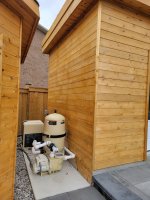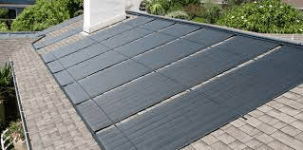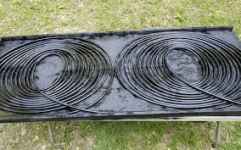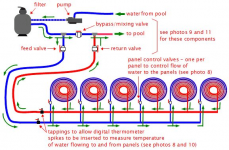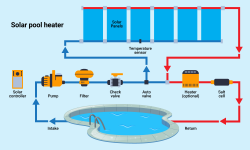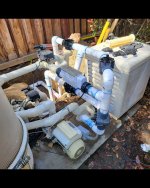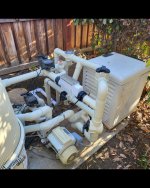Hi All. First I would like to comment on the great site and community here. I discovered TFP two days ago and haven't stopped reading and learning. Almost to a fault. Not a productive weekend on my part and I may have confused myself more than absorbing the right info.
We would like to install a hydronic solar heating system on the roof of the building (right one) in the pic. I am confused in which type of install may be most cost effect for install and operating. Coiled tubes in boxes, S shaped patterns on the roof, commercial panels etc.
Our pool surface area is 400 sq ft with a volume of 14K gallons. The cabana roof is a total 250 sq ft, flat. It is sloped ever so slightly for rain water run off. It is 12' floor to roof. Piping would not be a cost on its own as I have access to 1/2" up to 1". The pool pump is a 3hp pentair.
My initial thought of install was to tap in a supply and return to the pipe going into heater. I was thinking of installing a circulation pump on the return (vertically on the wall). I wasn't planning on installing a diverter valve for the solar loop, thinking the circulation pump will draw the water needed.?.
Before I ramble too long and risk jumping all over the place and risk providing irrelevant info, I will leave it at this point. If there is any info still needed please let me know.
We would like to install a hydronic solar heating system on the roof of the building (right one) in the pic. I am confused in which type of install may be most cost effect for install and operating. Coiled tubes in boxes, S shaped patterns on the roof, commercial panels etc.
Our pool surface area is 400 sq ft with a volume of 14K gallons. The cabana roof is a total 250 sq ft, flat. It is sloped ever so slightly for rain water run off. It is 12' floor to roof. Piping would not be a cost on its own as I have access to 1/2" up to 1". The pool pump is a 3hp pentair.
My initial thought of install was to tap in a supply and return to the pipe going into heater. I was thinking of installing a circulation pump on the return (vertically on the wall). I wasn't planning on installing a diverter valve for the solar loop, thinking the circulation pump will draw the water needed.?.
Before I ramble too long and risk jumping all over the place and risk providing irrelevant info, I will leave it at this point. If there is any info still needed please let me know.


